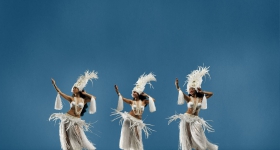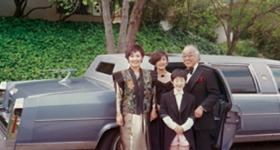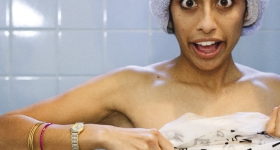Sipping horchata with performance artist/writer/rapper/comedian Kristina Wong in the back courtyard of Best Fish Taco in Ensenada is fitting. The small restaurant in the Los Feliz neighborhood in Los Angeles is just rickety enough for its unabashedly bold name to somehow make sense. Wong, too, might appear unassuming at first glance. She is casually dressed in jeans, her long black hair and petite frame set off by a bright blue shirt. With her backpack in tow, Wong is a walker — she’s carless in Los Angeles, so she walks or relies on public transportation, friends or even dates to get her around. But Wong is anything but casual; her intrepid performance work forcefully takes to task issues of white privilege, power and race (even when it doesn’t intend to) with a dauntless confidence.
Wong’s stage persona is big. She’s outrageous, but in the best way. She is a comedian who knows there is power in the use of her body and a performer who is resourceful enough to transgress categorical desire — her work lies at the intersection of theater, performance art, stand-up comedy and lecture. The physicality of Wong’s performances is integral to her work; her expressions, actions and costumes are meant to be goofy, awkward, imperfect and sometimes uncomfortable to watch. She does not hesitate to put her body in social jeopardy.
In a scene from her satirical infomercial, Asian Vaginas End Racism (2014), Wong’s arms and hands fly at the camera in a grasping or perhaps hexing motion. “Decolonize your thinking,” she wails. Her face peeks out of a homemade full-body vagina suit made from an array of flesh-toned fabrics. “Wow, my Asian vagina does have the power to end racism!” she says to the camera.
Unafraid to say or do what isn’t popular, Wong gets her point across. Asian Vaginas End Racism is a punchy critique of how dating or being friends with people of color is often used as social evidence that someone is not racist. In true Wong fashion, she takes the absurdity of that line of thought to its fullest extent by using the language of commercials and capitalism to sell viewers on the idea that white men can unlearn their racism by having sex with Asian women.
“When the white penis enters your Asian vagina, your clitoris engorges and re-educates the penis,” says a cheesy narrator as if selling a kitchen appliance, while Wong, still in costume, is penetrated by an enormous pink stuffed penis. The scene is delightfully ridiculous, though not for the faint of heart.
In person, Wong is expressive, articulate and ferociously smart. She is a UCLA graduate with degrees in world arts and culture as well as English. At UCLA, Wong began to trust her gut instincts and found inspiration in unexpected allies.
“I took a Chicano theater class and read the plays of Luis Valdez. Plays and theater were not only something in elite white institutions but were also used to organize farm workers. It was not just about a degree in theater,” she says. “Seeing the students in my class talk about Chicano identity was in dialogue with how we were describing Asian American identity. I didn’t even get the word ‘intersectionality’ then, but I was like, ‘Wow,’ … at this interesting shared experience as people on the margin.”
Wong exudes sincerity from the friendly glint in her eye and her warm smile, but don’t be fooled. On stage, this same look can be tweaked to appear wild. She is a master of nuance. Her control of her expressions, body movements and tone is part of what makes Wong’s performances so complex. Every moment is unstable because she challenges audience members’ assumptions about what they see.
Wong’s life has a way of blurring into her work. She has used OkCupid to fill seats in her shows. Her experience with online dating led to the creation of a reality TV show about men she encountered who had yellow fever. Wong realized that if white men would do anything to date her because she was an Asian woman, then she could get them to do just about anything — her “reparations for yellow fever.
In another ongoing performance, Wong played out a one-sided relationship with NBA player Jeremy Lin, that included holding up a homemade sign at an actual basketball game that said, “Restraining orders will NOT stop my love for you Jeremy. Happy VaLINtine’s Day!” This culminated in an unsuccessful Kickstarter campaign to support her goal of marrying the basketball player.
Wong employs a strategically makeshift aesthetic to most of her projects. Homemade props accommodate Wong’s desire to confound what is “true” or “real” because everything onstage could have been made by anyone in the audience.
Wong harnesses people’s desire to connect her stage presence to her real life as a narrative strategy. Wong typically presents projects from the first-person perspective as if they were dramatized from her own life. She is well aware that viewers will mistake a story told from a first-person perspective with an autobiography.
In Wong’s first major one-person show, Wong Flew Over the Cuckoo’s Nest (2011), she grapples with the reported high levels of depression and suicide among Asian American women. In the show, which toured for eight years, she “ends up satirizing [herself] as someone who sets out to make the impossible show” with the expectation that she and the audience will come to some sort of resolution about mental health and Asian America.
The audience and Wong embark on the same journey as equals. But as the audience watches her unravel over the course of the show, she shifts back and forth between being the subject and the object of her own performance. Instead of finding a tidy conclusion, audience members ask, “Is this unreliable narrator OK? Is she going to get us out of this crisis?”
From the beginning, Wong goes out of her way to convince, if not teach, the audience something about fiction — overemphasizing that what the audience is watching is “research that she has personalized” for the sake of the show. Yet the audience is continually confronted with the desire to position Wong as the depressed object. This skillful and precarious staging reoccurs throughout the show, and even Wong facetiously says in the opening sequence, “It’s a dramatic device, very high stakes.”
This is a constant strategy that Wong employs in her work — she repeatedly calls into question the expectations of the audience based on their own preconceived notions and prejudices about race, gender and class. If this is a performance about Asian American women and depression, of course Wong must suffer from depression. For Wong, these assumptions say much more about the audience’s beliefs than it does about her own experiences with mental illness.
Unsurprisingly, it became difficult for Wong to separate herself from the narrator of the play. “I learned a lot about how to care for myself. I think I let myself be too vulnerable early on in the process, and I had a lot of guilt because the show couldn’t fix the problem. I was like the living embodiment of the protagonist of the show.”
Wong’s work is physical; her body is her prop, tool and stage. Wong can’t help “[recreating] the narrative in my body. I’ve changed a lot in seven years, right? My body has changed, my life has changed, my memory has changed. But to carry out that same script again and again! I got really sick for years. I feel like I went through the gauntlet on that one.”
Wong’s muddle of herself and her work is indicative of her passion to create meaningful work. Though she may have wanted to move past heavy themes after Cuckoo’s Nest, Wong thought, “What big thing can I take on? What are people going to want to see? I’m not going to tackle it in a friendly, happy way.”
While it would be easy to position Wong’s work as sensational or loud, this desire to find difficult topics is what Wong considers “part of the challenge of an artist … I think what frustrated me in college, watching a lot of Asian American artists doing spoken word and stuff, is that it’s really easy to call out who is doing you wrong. It’s harder to find those pockets of joy in your oppression. When you can bring light to those, that is a much more poignant picture of the oppression. It’s not to say, ‘Be happy inside your oppression.’ There’s only so much ‘hate the man’ stuff I can watch.”
Wong is constantly trying to shuffle her life and perspective around — unsettling conformity or uprooting any chance of comfort. “If I’m going to live with a show for five years or more, I might as well be learning about something else. There’s only so much I can learn about not having a car, being a cat lady or being a depressed woman. It was taking up so much brain space that I felt like it was actually in my body.”
So Wong took a leap that landed her in Africa.
Her current one-person show, Wong Street Journal (WSJ), stems from experiences on her trip to post-conflict Gulu, Uganda, where she worked with the Women’s Global Empowerment Fund and Volunteer Action Network to produce their annual theater festival. Broadly speaking, WSJ tackles the mighty aspects of global poverty, but more cogently, she attacks the complicated dynamics of privilege. WSJ highlights Wong’s unexpected collaboration with local rap artists and producers to collectively create an album called Mzungu Price, which translates to “white woman.”
Wong is a third-generation Chinese American who grew up in the Sunset District, a residential neighborhood of San Francisco. She attended private schools and has spent most of her life speaking from the margins. It caught her by surprise that people in Uganda would consider her to be “white” and not a person of color. The more time Wong spent in Uganda, the more conspicuous her own privilege became, and much of WSJ reveals how the residue of imperialist thought and racism is embedded deep within the American psyche.
WSJ is a prime example of Wong’s self-awareness and care when handling topics such as race, power and privilege. While many of the subjects of her past performances fundamentally do not understand their own privilege, Wong is keenly and constantly rethinking hers.
“That’s what happened with all this Asian fetish stuff. I have all these white men writing me, saying ‘I’m not like that!’ and ‘Do I have an Asian fetish?’ If you lack the self-inquiry that you have to write a stranger to ask them that, then you don’t deserve my time,” she says about the aftermath of the yellow fever reality show.
It is a risky undertaking to ask audiences to confront their own privilege because privilege, as a form of power, operates most effectively when it is invisible, as Wong illustrates in her shows. Most of us obtain some level of privilege even if we speak from the margins or at the intersection of many identities. To not see this is a choice that Wong not only addresses in her work but also within herself.
“This is about microaggressions that can never be reversed. Bigger atrocities might need to be addressed by the government, but these smaller ones that we navigate every day — how do we take back the pockets of power and not just sit in this shitty space.”










Comments